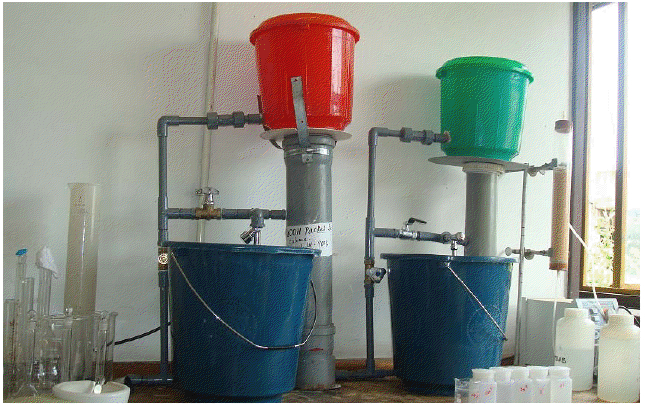Difference between revisions of "De-fluoridation"
| Line 1: | Line 1: | ||
[[Image:defluoridation unit.jpg|thumb|right|300px|Household defluoridation unit (HDU). Photo: ADDIS ABABA UNIVERSITY.]] | [[Image:defluoridation unit.jpg|thumb|right|300px|Household defluoridation unit (HDU). Photo: ADDIS ABABA UNIVERSITY.]] | ||
| − | High levels of fluoride in groundwater has been reported parts of in Ethiopia, Malawi, Kenya and Tanzania and can lead to health problems including dental fluorosis, osteosclerosis, thyroid problems, growth retardation and even kidney failure. Most of the methods currently available for the removal of fluoride from drinking water are either too expensive, are technically unfeasible for household use or change the water quality. The removal of fluoride from water using aluminium hydroxide has been investigated and a household defluoridation unit (HDU) has been designed and tested. | + | High levels of fluoride in groundwater has been reported parts of in Ethiopia, Malawi, Kenya and Tanzania and can lead to health problems including dental fluorosis, osteosclerosis, thyroid problems, growth retardation and even kidney failure. WHO report shows excessive fluoride intake (3-6 mg/L) can lead to severe and permanent bone and joint deformations of skeletal fluorosis and the consumption of drinking water with even higher fluoride concentrations (10 mg/L) can lead to crippling fluorosis, which causes the hardening and calcifying of the bones. |
| + | |||
| + | Most of the methods currently available for the removal of fluoride from drinking water are either too expensive, are technically unfeasible for household use or change the water quality. The removal of fluoride from water using aluminium hydroxide has been investigated and a household defluoridation unit (HDU) has been designed and tested. | ||
==Reference manuals, videos, and links== | ==Reference manuals, videos, and links== | ||
* [http://www.google.com/url?sa=t&rct=j&q=&esrc=s&source=web&cd=1&ved=0CFUQFjAA&url=http%3A%2F%2Facademicjournals.org%2Fijps%2FPDF%2FPdf2008%2FJan%2FSajidu%2520et%2520al.pdf&ei=uj28T42JNongiAKqjc3RDQ&usg=AFQjCNFooQaWbqF5gy4QqOoAek4C1Xrrog&sig2=E1v4ZlCDezF7WoXzr7ZlYg Groundwater fluoride levels in villages of Southern Malawi and removal studies using bauxite.] International Journal of Physical Sciences Vol. 3 (1), pp. 001-011, January, 2008. | * [http://www.google.com/url?sa=t&rct=j&q=&esrc=s&source=web&cd=1&ved=0CFUQFjAA&url=http%3A%2F%2Facademicjournals.org%2Fijps%2FPDF%2FPdf2008%2FJan%2FSajidu%2520et%2520al.pdf&ei=uj28T42JNongiAKqjc3RDQ&usg=AFQjCNFooQaWbqF5gy4QqOoAek4C1Xrrog&sig2=E1v4ZlCDezF7WoXzr7ZlYg Groundwater fluoride levels in villages of Southern Malawi and removal studies using bauxite.] International Journal of Physical Sciences Vol. 3 (1), pp. 001-011, January, 2008. | ||
| + | |||
| + | ==Acknowledgements== | ||
| + | * WONDIMAGEGN, AGEGNEHU ALEMU. [http://etd.aau.edu.et/dspace/bitstream/123456789/2531/1/193 DEVELOPMENT OF HOUSEHOLD DEFLUORIDATION UNIT BASED ON ALUMINIUM OXIDE HYDROXIDE.] December, 2008. | ||
Revision as of 06:21, 23 May 2012
High levels of fluoride in groundwater has been reported parts of in Ethiopia, Malawi, Kenya and Tanzania and can lead to health problems including dental fluorosis, osteosclerosis, thyroid problems, growth retardation and even kidney failure. WHO report shows excessive fluoride intake (3-6 mg/L) can lead to severe and permanent bone and joint deformations of skeletal fluorosis and the consumption of drinking water with even higher fluoride concentrations (10 mg/L) can lead to crippling fluorosis, which causes the hardening and calcifying of the bones.
Most of the methods currently available for the removal of fluoride from drinking water are either too expensive, are technically unfeasible for household use or change the water quality. The removal of fluoride from water using aluminium hydroxide has been investigated and a household defluoridation unit (HDU) has been designed and tested.
Reference manuals, videos, and links
- Groundwater fluoride levels in villages of Southern Malawi and removal studies using bauxite. International Journal of Physical Sciences Vol. 3 (1), pp. 001-011, January, 2008.
Acknowledgements
- WONDIMAGEGN, AGEGNEHU ALEMU. DEVELOPMENT OF HOUSEHOLD DEFLUORIDATION UNIT BASED ON ALUMINIUM OXIDE HYDROXIDE. December, 2008.

